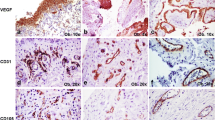Abstract
Neovascularization is indispensable to both bone remodeling and the development of chronic inflammation. A pro-angiogenic state in the periprosthetic tissue may augment the inflammatory response to wear debris. To investigate if a pro-angiogenic state exists in the bone–implant interface of aseptically loosened joint prosthesis, the expression of vascular endothelial growth factor (VEGF) and its receptor Flk-1/KDR were studied by immunohistochemistry. The VEGF-Flk/KDR pathway has been implicated as a key signaling requirement for pathological angiogenesis. The level of vascularization in periprosthetic tissue was semi-quantitatively compared to osteoarthritic (OA) and rheumatoid arthritic (RA) synovium. The level of vascularization in areas of periprosthetic tissue with heavy or low/moderate wear debris were also compared semi-quantitatively by image analysis.
High levels of VEGF expression (16/16 cases) particularly in the implant synovial-like lining layer together with Flk-1/KDR expression by endothelial cells (13/16), suggests that neovascularization is occurring. Morphometric comparison of periprosthetic tissue with RA and OA synovium revealed no significant difference in microvessel density, but did reveal significantly increased microvessel area in RA synovium (P> 0.05). Areas of high wear debris infiltrate also contained a significantly smaller microvessel area (P > 0.01). Suggesting that wear debris may cause behavioral modification of microvessels. Modifying angiogenesis in the periprosthetic tissue could be a potential therapeutic target in reducing inflammation.
© 2001 Kluwer Academic Publishers
Similar content being viewed by others
References
S. Santavirta, A. Ceponis, S. A. Solovieva, H. Hurri, J. Jin, M. Takagi, A. Suda and Y. T. Konttinen, Arch. Orthop. Trauma. Surg. 115 (1996) 286.
J. R. Jackson, M. P. Seed, C. H. Kircher, D. A. Willoughby and J. D. Winkler, FASEB J. 11 (1997) 457.
N. Ferrara and K. Alitalo, Nat. Med. 5 (1999) 1359.
R. A. Swerlick and T. J. Lawley, J. Invest. Dermatol. 100 (1993) 111S.
T. Imaizumi, H. Itaya, S. Nasu, H. Yoshida, Y. Matsubara, K. Fujimoto, T. Matsumiya, H. Kimura and D. Satoh, Thromb. Haemo. 83 (2000) 949.
J. Trueta, J. Bone Joint Surg. 45 (1963) 402.
S. C. Ballara, J. M. Miotla and E. M. Paleolog, Int. J. Exp. Pathol. 80 (1999) 235.
H.-P. Gerber, T. H. Vu, A. M. Ryan, J. Kowalski, Z. Werb and N. Ferrara, Nat. Med. 5 (1999) 623.
B. Decker, H. Bartels and S. Decker, Anat. Rec. 242 (1995) 310.
A. R. Jones, C. C. Clark and C. T. Brighton, J. Orthopaedic Res. 13 (1995) 553.
J. W. Xu, Y. T. Konttinen and J. Lassus, Clin. Exp. Rheum. 14 (1996) 643.
G. Mcmahon, Oncologist 5S1 (2000) 3.
N. Ferrara, K. Carver-Moore, H. Chen, M. Dowd, L. Lu, K. S. O'Shea, L. Powell-Braxton, K. J. Hillan and M. W. Moore, Nature 380 (1996) 439.
H. Sone, Y. Kawakami, M. Sakauchi, Y. Nakamura, A. Takahashi, H. Shimano, Y. Okuda, T. Segawa, H. Suzuki and N. Yamada, Biochem. Biophys. Res. Comm. 23 (2001) 562.
J. Waltenberger, L. Claesson-Welsh, A. Siegbahn, M. Shibuya and C.-H. Heldin, J. Biol. Chem. 268 (1994) 26988.
A. Giatromanolaki, E. Sivridis, N. Athanassou, E. Zois, P. E. Thorpe, R. A. Brekken, K. C. Gatter, A. L. Harris, I. M. Koukourakis and M. I. Koukourakis, J. Pathol. 194 (2001) 101.
M. Ikeda, Y. Hosoda, S. Hirose, Y. Okada and E. Ikeda, ibid. 191(2000) 426.
N. Al-Saffar and P. A. Revell, J. Long-Term Effects of Med. Impl. 9 (1999) 319.
N. Al-Saffar, J. T. L. Mah, Y. Kadoya and P. A. Revell, Ann. Rheum. Dis. 54 (1995) 201.
C. R. Stevens, R. B. Williams, A. J. Farrel and D. R. Blake, Ann. Rheum. Dis. 50 (1991) 124.
M. Wagner, I. Hermanns, F. Bittinger and C. J. Kirkpatrick, Am. J. Physiol. 277 (1999) L1026-33.
C. R. Stevens, D. R. Blake, P. Merry, P. A. Revell and J. R. Levick, Arthritis Rheum. 34 (1991) 1508.
Author information
Authors and Affiliations
Corresponding author
Rights and permissions
About this article
Cite this article
Jell, G., Al-Saffar, N. Does a pro-angiogenic state exist in the bone–implant interface of aseptically loosened joint prosthesis?. Journal of Materials Science: Materials in Medicine 12, 1069–1073 (2001). https://doi.org/10.1023/A:1012858426382
Issue Date:
DOI: https://doi.org/10.1023/A:1012858426382




